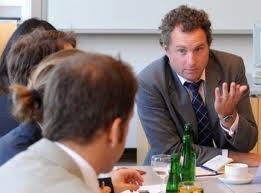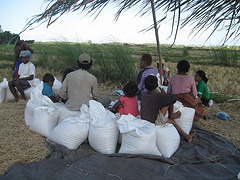We took his word for it. Few people know more about moving the nuts and bolts of humanitarian missions than Gilmore. He’s dedicated his life to improving these logistics. “It’s really easy,” says the executive director of Peace Dividend Trust. “The global logistics industry is so simple.”
Simple is one thing. But efficiency in places like Afghanistan, Haiti and Africa is another. “When it comes to supply chains and managing people, the aid industry is decades behind the private sector,” says Gilmore. “We can help [these organizations] spend locally.”
Wading through the red tape
Gilmore knows buying local isn’t synonymous with easy, but it is efficient. While working as a diplomat in East Timor he saw just how wasteful aid could be. Supplies were held up at borders and on ships while in-country managers helplessly waited for the red tape to be sorted out overseas.
Scott Gilmore
“We were very frustrated at the fact that peacekeeping missions were limited by lack of attention to the nuts and bolts,” says Gilmore. But he did see positive change through his own day-to-day personal spending living in the country. Buying food and personal items generated more income for the local economy than the guarded shipping containers. He figured if he could recreate this growth on a larger scale, he could make missions cheaper, smarter, and more effective. “We want to make it as easy as possible for even the laziest procurement officer to spend money locally,” he explains.
Peace Dividend Trust set up their flagship project in Afghanistan in 2006. There, he found Westerners working as procurement officers – people who purchase supplies in the field – who didn’t speak the language and were concerned about personal safety. “He’s probably just heard someone got kidnapped,” says Gilmore. “He’s scared about the security, so he doesn’t leave the compound.” The officer makes a phone call and gets aid shipped from Pakistan and or flown from Dubai. Instead, Gilmore’s team looked to the local private sector.
Working the local angle
Building
When Afghanistan was invaded, many had difficulty finding reliable local suppliers. But, as Kai Eide, the U.N. Special Representative to Afghanistan, told a conference in Kabul, “This is not 2002 anymore…There are Afghan companies today which can supply the international community.” Peace Dividend Trust found them.
The team headed into cities like Kabul, Kandahar and Jalalabad and sought our owners of medium-sized businesses. “Not just businesses out of a suitcase,” says Gilmore. They would vet them, record their services and compile the information. Then, they gave owners training on how to bid for contracts. To connect aid agencies, the team sometimes brought business owners directly to compounds to negotiate a price – sometimes half that of shipping internationally.
Today, Peace Dividend Trust has created an online directory of 4,400 Afghan companies. In the process, they have directed $476 million of aid money into the local economy. “It’s one of the single largest drivers of economic growth and job creation,” says Gilmore. “That meant focused aid was not as successful as this accidental income generation.”
Peacekeeping
Replicating a model that works
The Afghanistan model was so successful the United Nations asked for it to be replicated in Haiti prior to the earthquake. In June 2009, Peace Dividend Trust started vetting local companies. Since the earthquake, that directory has become integral to Haiti’s recovery. “We go out and find Haitian companies and verify they are up and running,” says Gilmore. “Then we can make sure the money being spent on Haiti actually gets spent in Haiti.”
For aid to be effective, it needs to be an investment in communities. By using in-country operations to create jobs and provide alternative forms of income, this creates stability and a positive relationship between donor and receiving countries.
This is just the kind of double bottom line that can help create a more effective system of aid in the developing world. It’s something we hope to see more of as the field of social entrepreneurship expands. By applying proven, market-based practices with an added measure of positive social gain, it helps marry the ideas of efficiency and effectiveness. In turn, this can transform aid from a system currently based on charity into something that gets communities involved and ensures local populations have a hand in their own development.
In all of our communities, from rural Kenya to earthquake-ravaged Haiti, we’ve found that no one is looking for handouts. Instead, people want hand-ups as they look for empowerment in breaking the cycle of poverty. We can make that happen by assessing local capacities and ensuring that aid dollars are spent efficiently in the communities that need them.
Solutions exist by buying local. We need to see past easy and start thinking efficient.
Craig and Marc Kielburger are the co-founders of Me to We, a social enterprise that challenges traditional methods of doing business by providing people with daily choices that can truly change the world.




